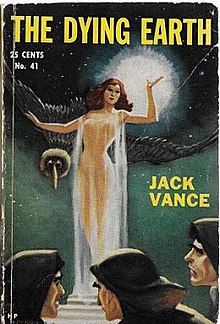The Dying Earth

Front cover of the first edition
|
|
| Author | Jack Vance |
|---|---|
| Cover artist | uncredited (first) |
| Country | United States |
| Language | English |
| Series | Dying Earth |
| Genre | Fantasy short story collection, Dying Earth subgenre |
| Publisher | Hillman Periodicals |
|
Publication date
|
1950 |
| Media type | Print (paperback) |
| Pages | 175 or 176 pp (first) |
| OCLC | 8479962 |
| Followed by | The Eyes of the Overworld |
The Dying Earth is a collection of fantasy short fiction by American writer Jack Vance, published by Hillman in 1950. Vance returned to the setting in 1965 and thereafter, making it the first book in the Dying Earth series. It is retitled Mazirian the Magician in its Vance Integral Edition (2005), after the second of six collected stories.
The Internet Speculative Fiction Database calls it a "slightly connected series of stories" but it was ranked number 16 of 33 "All Time Best Fantasy Novels" by Locus in 1987, based on a poll of subscribers.
Similarly, it was one of five finalists for the Best Novel "Retro Hugo" in 2001 when the World Science Fiction Society provided 50th anniversary recognition for a publication year without Hugo Awards.
All six stories were original to the collection.
The stories are all set in an undefined far future Earth, when the sun is nearing the end of its life. The sky ranges from pink to deep blue, lit by a dim red sun, and many strange plants and animals exist. Much of the story is set within the forested country of Ascolais, and in the ruined cities that dot the landscape.
The setting is marked by the presence of unaccountably ancient ruins and other fragments of now-decayed civilizations. The human population is shrinking, and most live in the remaining structures built long ago, in varying degrees of ruin, squalor, or luxury. In addition, many people make use of technology or magic which was created long ago, but which they no longer understand. No distinction is ever made between technology created through science and that created by magic; the line between the two is blurred, and it is heavily implied that the two are ultimately indistinguishable. The characters in the stories are aware that they live on a "Dying Earth" and often make carefree, nihilistic references to the fact that their planet does not have much longer to live, assuming that the sun will soon burn itself out. It is never explained how long the Earth has left to live; it could be only decades, or possibly still thousands or millions of years.
...
Wikipedia
